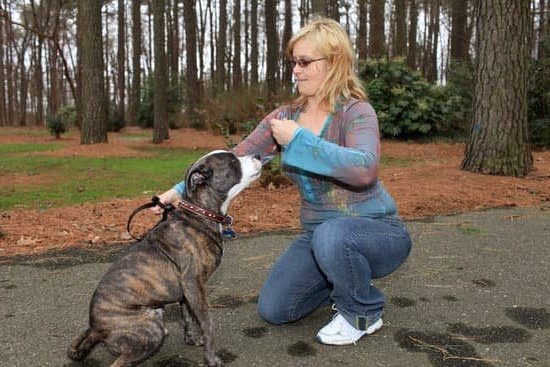Herding dogs are known for their intelligence, agility, and strong work ethic, making them indispensable assets on farms and ranches. But how early should you begin training a herd dog to maximize their potential? Starting the training process early is crucial in shaping a well-rounded and obedient herding companion.
Early training not only helps develop a strong bond between the dog and handler but also establishes clear boundaries and expectations from a young age. By starting training early, you can channel the natural instincts of herd dogs in the right direction and prevent behavioral issues down the line.
In this article, we will delve into the benefits of early training for herd dogs, understanding their innate instincts, socialization techniques, basic obedience commands, as well as tools and methods for effective training. Additionally, we will explore breed-specific considerations and common challenges faced when training herd dogs at a young age along with practical tips to maintain consistency and patience throughout the training process.
Benefits of Early Training for Herd Dogs
Improved Behavior and Performance
Early training for herd dogs can significantly improve their behavior and performance in the long run. By starting training at a young age, you are laying the foundation for desired behaviors and skills that will benefit both the dog and the handler. Dogs that receive early training are more likely to understand commands, exhibit better manners, and perform tasks efficiently as they grow older. This early training also helps in shaping their instincts and natural abilities towards herding tasks.
Stronger Bond With Handlers
Training a herd dog from a young age allows for the development of a strong bond between the dog and its handler. Through consistent training sessions, the dog learns to trust and respect its owner, which enhances communication and teamwork during herding activities. This bond is crucial for effective working relationships between herd dogs and their handlers, leading to a more successful partnership in managing livestock.
Prevention of Behavioral Issues
One of the key benefits of early training for herd dogs is the prevention of behavioral issues later in life. Proper socialization, obedience training, and exposure to different environments at a young age help prevent common behavioral problems such as aggression, excessive barking, or disobedience.
By addressing these issues early on through positive reinforcement techniques, herd dogs are less likely to develop problematic behaviors as they mature. Consistent training from an early age sets a solid foundation for well-behaved and reliable herd dogs in the future.
Understanding the Natural Instincts of Herd Dogs
Herding dogs have been bred for centuries to work alongside humans in managing livestock. Their innate instincts drive them to control and move animals in a specific direction, making them valuable assets on farms and ranches. Understanding these natural instincts is crucial when considering how early to begin training a herd dog.
From a young age, herd dogs exhibit behaviors such as circling, chasing, barking, and nipping – all of which are rooted in their genetic makeup. These behaviors can be honed through proper training to ensure that they are effectively channeled towards herding tasks. Starting the training process early allows these instincts to be shaped and directed in a positive way, making the dog more efficient and reliable when working with livestock.
Typically, herd dogs can begin their training as early as 8 weeks old. This is an ideal time to start introducing basic commands, socialization with other animals, and positive reinforcement techniques.
By starting at this young age, herd dogs can develop good habits early on and establish a strong foundation for more advanced training as they grow older. Consistency and patience are key when training herd dogs from a young age, as it takes time for them to fully grasp the concepts being taught.
| Benefits of Early Training | Understanding Natural Instincts |
|---|---|
| Establishes good habits | Behaviors rooted in genetic makeup |
| Builds a strong foundation | Instincts honed through training |
| Promotes efficient work with livestock | Begins at around 8 weeks old |
Socialization and Basic Obedience Training for Young Herd Dogs
When considering how early to begin training a herd dog, it is essential to start as early as possible. Puppies have a critical socialization period between 3 weeks and 3 months of age, during which they are most receptive to new experiences and learning. By starting training during this period, you can help your herd dog develop important social skills and prevent behavioral issues later on. Early socialization also helps young dogs become well-adjusted and confident in various environments.
Basic obedience training is crucial for young herd dogs to learn at an early age. This includes commands such as sit, stay, come, and heel. By teaching these commands early on, you can establish a foundation for more advanced training as your dog grows older.
Consistent and positive reinforcement is key during this stage of training to ensure that your herd dog understands what is expected of them. Training sessions should be kept short and fun to keep your puppy engaged and eager to learn.
In addition to obedience training, exposing young herd dogs to different people, animals, sights, sounds, and environments is essential for their social development. This exposure helps prevent fearfulness and aggression towards unfamiliar situations in the future.
By gradually introducing your puppy to new experiences in a positive way, you can help them become a well-rounded and well-behaved adult dog. It’s important to remember that each dog is unique, so be patient and tailor your training approach to suit your individual herd dog’s needs.
| Early Training Benefits | Details |
|---|---|
| Socialization Period | 3 weeks to 3 months of age is crucial for new experiences |
| Basic Obedience Commands | Commands like sit, stay, come, heel set the foundation for further training |
| Social Exposure | Exposure to people, animals, sights helps prevent fearfulness in future |
Basic Commands and Tasks for Herd Dogs to Learn Early On
Training a herd dog from a young age is crucial in order to develop their natural instincts and abilities. Early training lays the foundation for a successful working relationship between the dog and its handler, making it easier to manage and control the herd effectively. But how early should you begin training a herd dog?
The answer varies depending on the breed, but in general, starting as early as 8 weeks old is ideal. This allows for the puppy to start learning basic commands and tasks while also developing socialization skills.
One of the most important commands for a herd dog to learn early on is “come.” Teaching a young dog to come when called can help prevent them from wandering off when working with livestock or when out in open spaces.
This command also ensures that the dog can be easily controlled and directed during herding tasks. Another essential command is “stay,” which helps with managing the dog’s movements and ensuring they do not get too aggressive or anxious around livestock.
In addition to basic commands, introducing tasks such as walking on a leash, sitting, and staying calm around other animals are important for young herd dogs. These tasks not only instill discipline in the dog but also help build their confidence in various environments. By starting these training exercises early on, you can set your herd dog up for success in their role as a valuable asset on the farm or ranch.
Training Tools and Techniques for Effective Herd Dog Training
Training a herd dog from a young age requires the use of appropriate tools and techniques to ensure effective learning and development. Here are some essential training tools and techniques that can be utilized:
- Whistle or commands: Utilizing a whistle or specific verbal commands consistently during training sessions can help herd dogs understand what is expected of them. This helps in establishing clear communication between the trainer and the dog.
- Positive reinforcement: Using treats, praise, or toys as rewards for desired behaviors can be an effective way to motivate and encourage herd dogs during training. This positive reinforcement helps in reinforcing good behavior and creating a strong bond between the dog and handler.
- Clicker training: Clicker training involves using a clicker device to create a distinct sound signal to mark desired behaviors in herd dogs. Pairing the click with treats or rewards helps in shaping behaviors quickly and efficiently.
Employing these tools and techniques consistently can support the learning process of young herd dogs and aid in their overall development as working animals. By incorporating positive reinforcement strategies, clear communication methods, and innovative training tools like clickers, handlers can effectively train their herd dogs from an early age.
It is crucial for trainers to adapt their tools and techniques based on the individual needs and learning styles of different breeds. While some herding breeds may respond well to certain methods, others may require more patience and alternative approaches. Understanding the breed-specific characteristics of herd dogs can help trainers tailor their training programs accordingly, ensuring successful outcomes for both the dog and handler.
Incorporating a mix of different tools and techniques into training sessions not only keeps things engaging for young herd dogs but also helps in addressing any challenges that may arise during the learning process. Overall, using effective tools and techniques is essential in setting up herd dogs for success in their role as working animals while nurturing a strong bond with their handlers.
Considerations for Different Breeds and Their Training Timelines
Different dog breeds may have varying timelines for when they are ready to begin training as herd dogs. It is essential to consider the unique characteristics and instincts of each breed to determine how early to start their training. Here are some considerations for different breeds and their training timelines:
- Border Collie: Border Collies are known for their intelligence and high energy levels, making them excellent herd dogs. They are typically ready to begin training as early as 8 weeks old. Early socialization and basic obedience training are crucial for Border Collies to ensure they develop into well-rounded working dogs.
- Australian Shepherd: Australian Shepherds are another popular breed for herding livestock. They are intelligent and highly trainable, but they may have a slightly longer timeline for training compared to Border Collies. Starting training around 10-12 weeks old is ideal for Australian Shepherds, allowing them to develop their skills gradually.
- German Shepherd: German Shepherds are versatile working dogs that excel in various tasks, including herding. They are typically ready to start training around 8-10 weeks old. Consistent and patient training is key for German Shepherds, as they can be sensitive to harsh handling.
Each breed has its own unique characteristics and strengths when it comes to herding, so it is essential to tailor the training timeline accordingly. By starting the training process at the right age and using appropriate techniques, you can help your herd dog reach its full potential in working with livestock.
Common Challenges in Training Herd Dogs at a Young Age and How to Overcome Them
Training herd dogs at a young age can be a rewarding experience, but it also comes with its own set of challenges. Understanding these challenges and how to overcome them is crucial for successful training. Here are some common challenges that dog owners may face when training herd dogs at a young age, along with tips on how to address them effectively.
Lack of Attention Span
One of the main challenges in training young herd dogs is their short attention span. Puppies, in particular, may have difficulty focusing for long periods of time. To overcome this challenge, it is important to keep training sessions short and engaging.
Use positive reinforcement techniques such as treats and praise to keep your dog motivated and focused during training. Break down training tasks into smaller steps and gradually increase the duration of training sessions as your dog’s attention span improves.
Impulsiveness
Another common challenge when training young herd dogs is their impulsiveness. Herding breeds are known for their high energy levels and eagerness to chase after moving objects. To address this challenge, it is essential to provide plenty of mental stimulation and physical exercise for your dog outside of training sessions.
This can help channel their energy in a positive way and reduce impulsive behavior during training. Incorporating interactive toys, agility exercises, and playtime into your dog’s daily routine can help manage their impulsiveness.
Socialization Issues
Young herd dogs may also struggle with socialization issues, especially if they are not exposed to different people, animals, and environments early on. Proper socialization is key to preventing fearfulness, aggression, or anxiety in adult dogs. To overcome socialization challenges, introduce your dog to various stimuli in a structured and positive manner from a young age.
Enroll them in puppy classes, organize playdates with other dogs, expose them to different sights and sounds, and reward calm and confident behavior around new experiences. Consistent socialization will help your herd dog become well-adjusted and confident in different situations as they grow older.
By addressing these common challenges in training young herd dogs effectively, you can set a solid foundation for their development into well-behaved working companions. Patience, consistency, positive reinforcement, and early socialization are key factors in shaping the behavior of herd dogs at a young age. Remember that every dog is unique, so tailor your training approach based on your dog’s individual needs and personality traits for optimal success in their herding tasks in the future.
Tips for Maintaining Consistency and Patience in Training Herd Dogs From a Young Age
Training a herd dog from a young age is crucial in developing their skills and ensuring they become valuable assets on the farm or ranch. Consistency and patience are key elements in the training process to help these dogs understand your expectations and perform their tasks effectively.
To maintain consistency, it is important to establish a routine for training sessions. Set aside dedicated time each day to work with your herd dog, reinforcing commands and practicing tasks. Consistency in both the timing and content of training sessions will help the dog understand what is expected of them and create a sense of structure that they can rely on.
Patience is equally important when training herd dogs from a young age. Remember that these dogs are still learning and may not grasp commands immediately. Stay calm and composed during training sessions, providing clear instructions and rewards for desired behaviors. Avoid becoming frustrated if progress is slow, as this can hinder your dog’s confidence and willingness to learn. Positive reinforcement is key in maintaining patience throughout the training process.
In conclusion, starting herd dog training at an early age sets the foundation for a successful partnership between you and your canine companion. By understanding the importance of consistency and patience in training, you can help your herd dog reach their full potential and become an invaluable part of your operation. Remember to be patient, consistent, and positive in your approach to ensure that your furry partner thrives in their role on the farm or ranch.
Frequently Asked Questions
What Age Should You Start Training a Herding Dog?
Training a herding dog should ideally start when they are still puppies, around 8-12 weeks old. This is the best time to establish good habits and begin socialization. Starting early can help shape their behavior positively for the future.
When Should I Start Training My Sheep Dog?
The ideal time to start training a sheep dog is also when they are still young, typically around 8-16 weeks old. This is a critical period for their development and training during this time can have a significant impact on their behavior and skills as they grow older.
What Is the First Step in Training Herding Dogs?
The first step in training herding dogs is building a strong foundation of basic obedience commands such as sit, stay, come, and walking on a leash. These commands lay the groundwork for more advanced herding training later on. Consistency and positive reinforcement are key elements in this foundational training phase.

Welcome to the blog! I am a professional dog trainer and have been working with dogs for many years. In this blog, I will be discussing various topics related to dog training, including tips, tricks, and advice. I hope you find this information helpful and informative. Thanks for reading!





